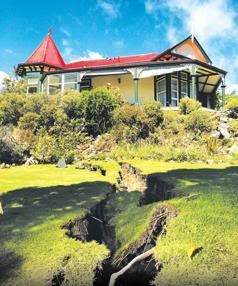Kiwithrottlejockey
Admin Staff
XNC2 GOD

Posts: 32250
Having fun in the hills!
|
 |
« Reply #50 on: March 06, 2011, 12:58:34 pm » |
|
Auckland's quake fix go-slowBy GREG NINNESS - Sunday Star-Times | 5:00AM - Sunday, 06 March 2011 SHAKE-UP: The damage to land and buildings SHAKE-UP: The damage to land and buildings
in Lyttelton and Christchurch has thrown the
focus onto regulations governing earthquake-
prone buildings in other areas.
— Photo: NATASHA MARTIN.THE CHRISTCHURCH EARTHQUAKE is raising doubts about the safety of buildings in Auckland, even if they have been strengthened to council standards, already lower than those applied in Wellington.
More than 2700 at-risk buildings were identified by the old Auckland City Council, but assessments have now been delayed by a year because of the super city amalgamation and the need to develop a new policy for earthquake-prone buildings.
Currently, owners of earthquake-prone buildings in central Auckland are allowed to take up to 30 years to strengthen them, the same time-frame allowed by the Christchurch City Council.
Some owners will have longer than that because the council has not yet finished assessing all buildings, making it likely that many owners will not have been told they need to do remedial work to bring their buildings up to scratch. Some buildings will not be strengthened until 2045.
Auckland's Earthquake Prone Buildings Policy, adopted by the former Auckland City Council, which has since been merged into the super city structure, adopted what it termed "a pragmatic approach" to the strengthening of the city's at-risk buildings.
The first stage involved compiling "a list of all buildings which could potentially be earthquake-prone". This was due to be completed by December 2007.
The second stage involved a more detailed evaluation of each building identified as at-risk in stage one. This was due to be finished by the end of next year, but has been delayed by a year by the super city changes.
The third stage involved compiling a register of at-risk buildings and prioritising them for strengthening work. No deadline was given for this.
Strategic at-risk buildings, those which would play a critical role in a major emergency such as hospitals or civil defence centres, would be given 10 years to do strengthening work.
Buildings that contained large numbers of people or that contained items of "high value to the community", such as museums, were to be strengthened by 2019.
Most other at-risk buildings would have until 2045 to complete strengthening work.
There are, however, serious doubts about how safe many Auckland buildings would be, even after strengthening work.
Buildings are considered earthquake-prone when they meet a third or fewer of the current standard for new buildings. So when they are strengthened, they only need to be strengthened to withstand 34% of the seismic loadings that new buildings are designed to withstand.
Adam Thornton, a director of Wellington-based structural engineering consultancy Dunning Thornton, which has overseen many building strengthening projects, said it was unlikely a building that had been strengthened to the minimum 34% standard would survive an earthquake like that experienced in Christchurch last month.
"Really, you wouldn't expect a building like that to withstand last week's quake," he said.
Even new buildings in Auckland may be more at risk of collapse compared with those in other parts of the country, because the city had lower building standards than places such as Wellington, where earthquakes were more common.
"If you designed a new building in Auckland [that complied with the city's building code] and put it on a truck and moved it down to Wellington, down here it could be earthquake-prone," Thornton said.
Wellington City Council requires its at-risk buildings to be strengthened within five to 15 years, depending on the type of building, half the time allowed in Auckland and Christchurch.
And Wellington's rules could be tightened even further. The council is due to consider a review of the current regulations later this month.
One of the main reasons for the differences in the building policies of councils in different parts of the country, was in the level of earthquake risk in each area.
Auckland is in an area considered to be at low risk of suffering a major quake, Christchurch is located in an area of medium risk, and Wellington is considered high risk.
"These earthquake-prone policies are a managed risk thing," Thornton said.
"You say OK, the risk of a major earthquake in any 20-year period is very small. So you allow people to go on living and working in substandard buildings because the risk is small and you can justify it on that basis."
"But when the risk is realised, as it was in Christchurch, it's bloody terrible."
Auckland City's manager of policy, training and resolutions Bob de Leur, said work done by the [pre-amalgamation] Auckland City Council had identified 2700 buildings which were potentially earthquake prone, of which 412 were made of unreinforced masonry, the type of building considered most at risk of collapse in an earthquake.
But the assessment process had been set back by 12 months by the need to develop a common building policy, to replace the different policies of the seven councils that were merged to form the super city.
Developing the new policy would include a public consultation process, which could review the time-frames allowed for strengthening at-risk buildings, he said.http://www.stuff.co.nz/sunday-star-times/business/4733428/Aucklands-quake-fix-go-slow
|